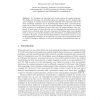Free Online Productivity Tools
i2Speak
i2Symbol
i2OCR
iTex2Img
iWeb2Print
iWeb2Shot
i2Type
iPdf2Split
iPdf2Merge
i2Bopomofo
i2Arabic
i2Style
i2Image
i2PDF
iLatex2Rtf
Sci2ools
DLT
2006
2006
Finding Lower Bounds for Nondeterministic State Complexity Is Hard
We investigate the following lower bound methods for regular languages: The fooling set technique, the extended fooling set technique, and the biclique edge cover technique. It is shown that the maximal attainable lower bound for each of the above mentioned techniques can be algorithmically deduced from a canonical finite graph, the so called dependency graph of a regular language. This graph is very helpful when comparing the techniques with each other and with nondeterministic state complexity. In most cases it is shown that for any two techniques the gap between the best bounds can be arbitrarily large. The only exception is the biclique edge cover technique which is always as good as the logarithm of the deterministic or nondeterministic state complexity. Moreover, we show that deciding whether a certain lower bound w.r.t. one of the investigated techniques can be achieved is in most cases computationally hard, i.e., PSPACE-complete and hence is as hard as minimizing nondeterminist...
Related Content
| Added | 30 Oct 2010 |
| Updated | 30 Oct 2010 |
| Type | Conference |
| Year | 2006 |
| Where | DLT |
| Authors | Hermann Gruber, Markus Holzer |
Comments (0)

